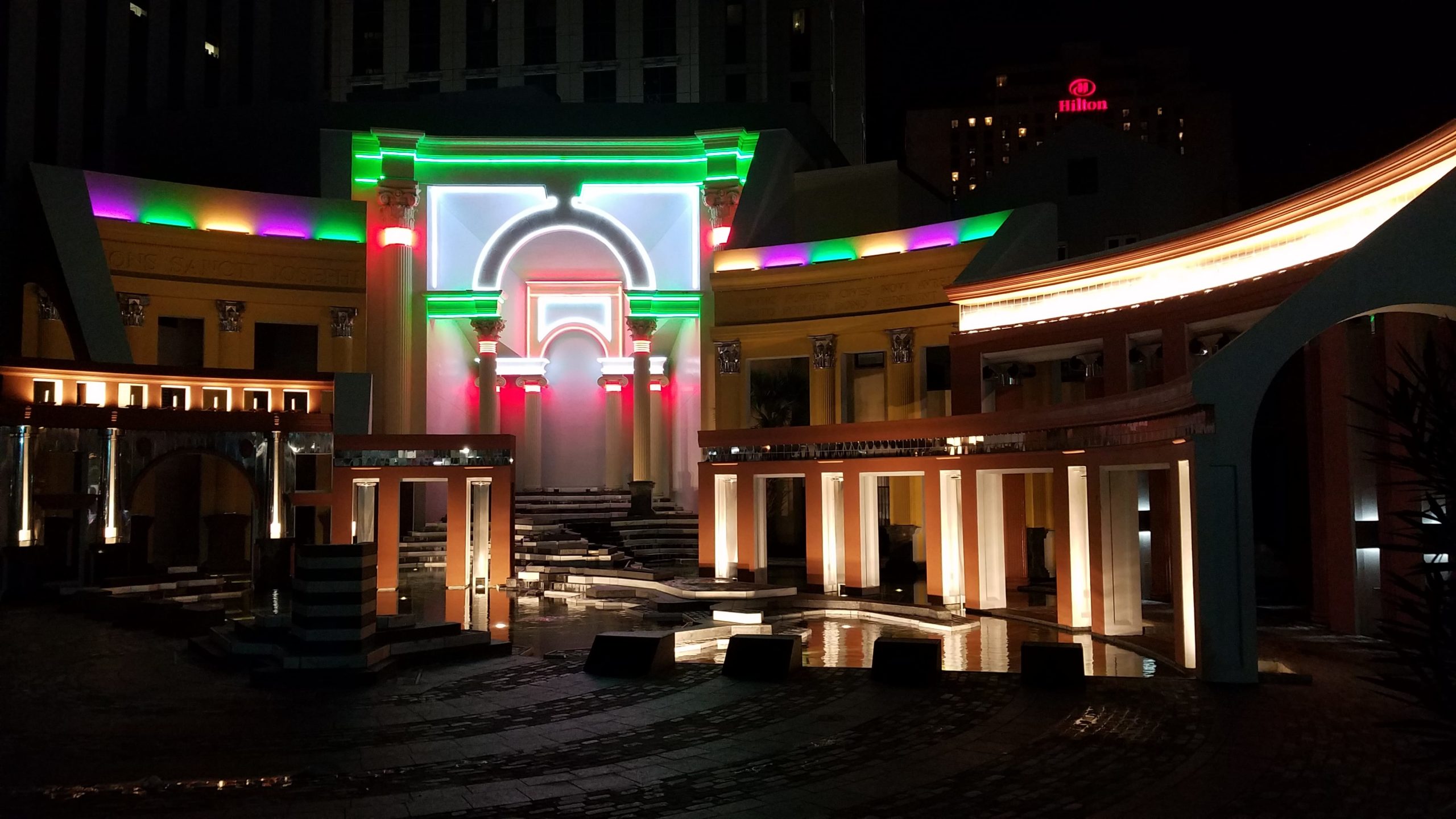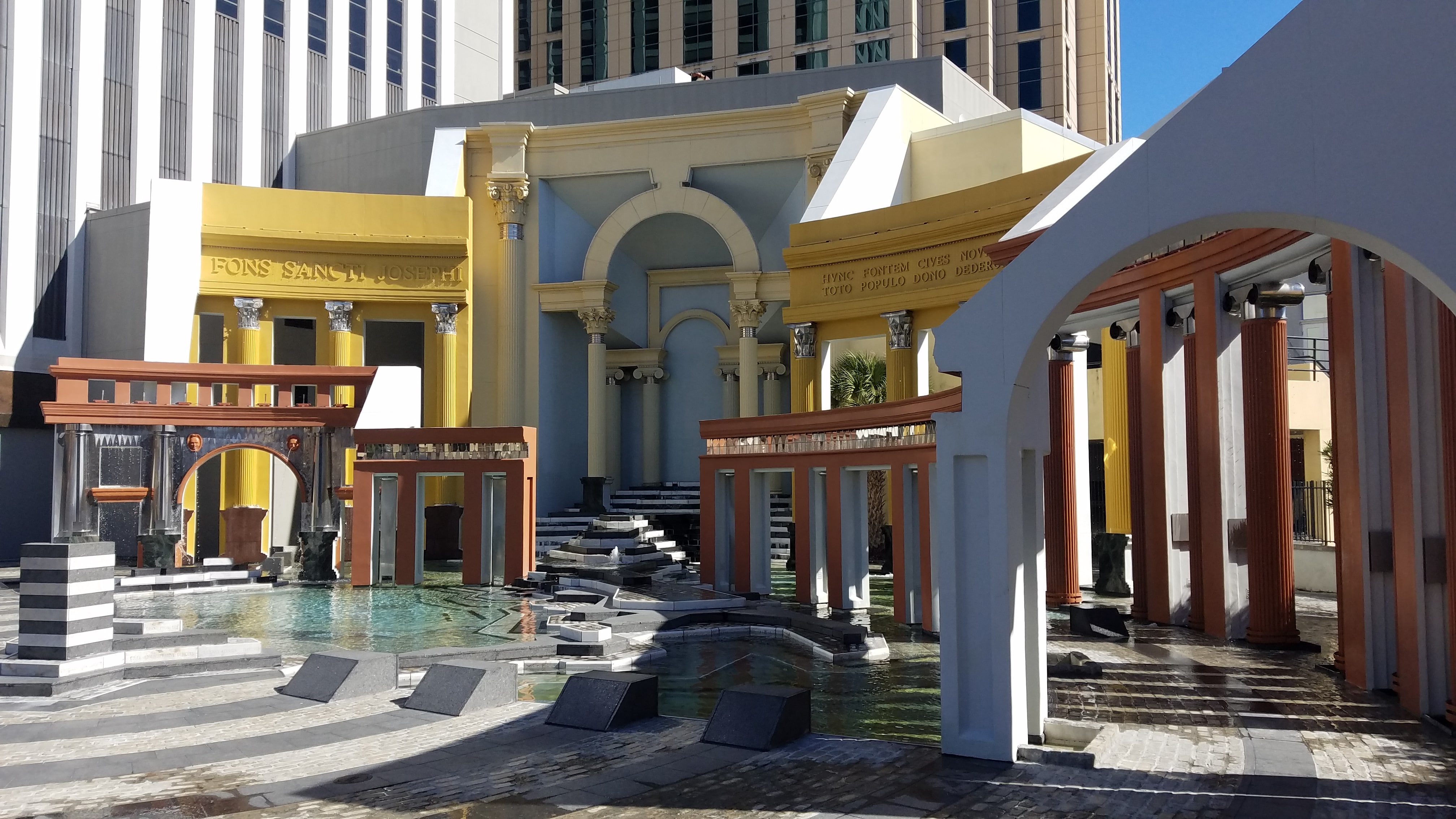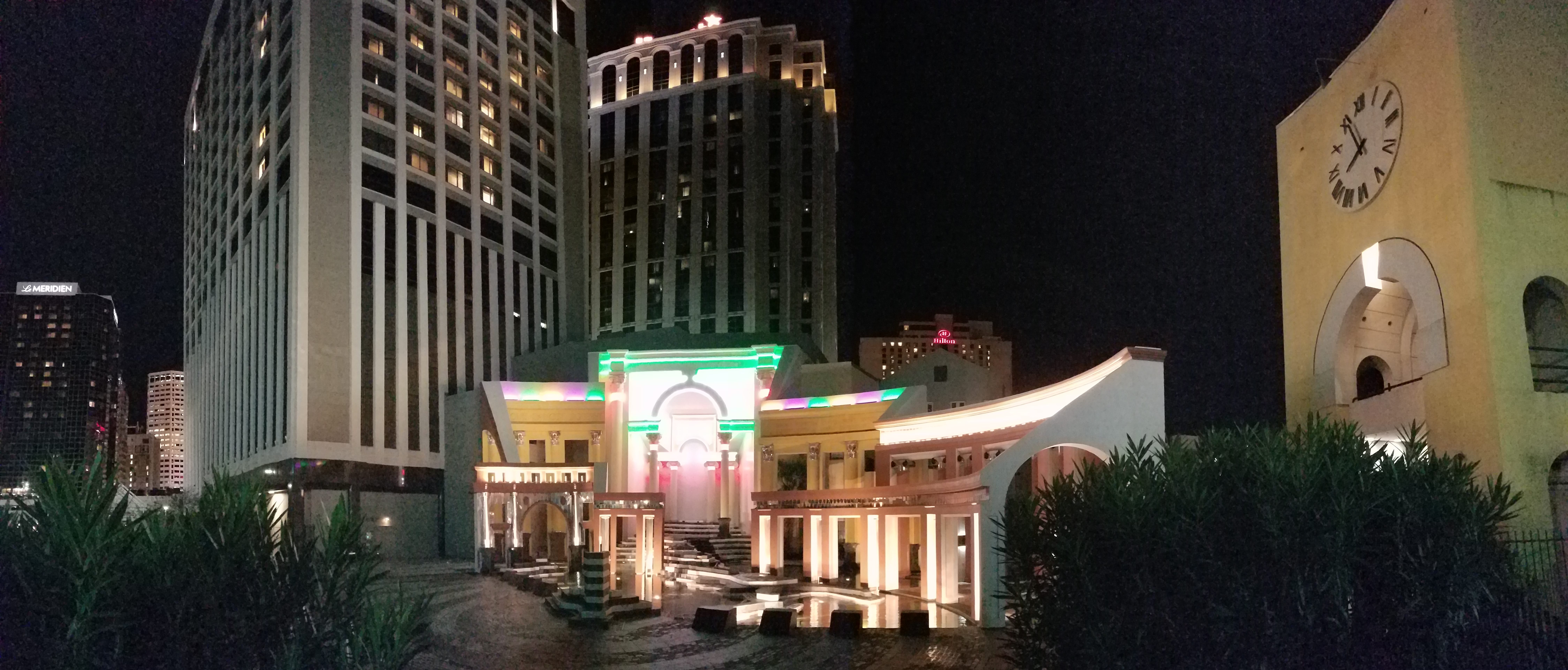On a crisp, New Orleans winter day, maybe you’re thinking of that summer vacation you went on to Italy. The vibrant colors. The people. The charming piazzas you can tuck into to eat your lunch or sip on wine.
But here’s one of New Orleans’ best-kept secrets: we have a piazza of our own right smack in the middle of downtown. And, even though it’s just a few steps off Poydras Street, it’s hidden from the eyes and minds of most New Orleanians.
The space is called Piazza d’Italia, and it takes up a piece of the block surrounded by Poydras Street and the Loew’s Hotel downriver, the American Italian Cultural Center and St. Peters Street on the river-side, Lafayette Street upriver, and a parking lot and Tchoupitoulas Street on the lake-side.
A couple visiting from St. Louis — the only other visitors to the piazza that morning — asked me to take a picture of them with their adorable toddler (who was not as adorable as a New Orleans toddler, obviously). Pools, fountains, columns sequenced into colonnades, a massive clock tower, and a peninsula in the shape of Italy led to steps up to a Roman temple — all painted in the colors of clay, mustard, light blue, silver, and beige.
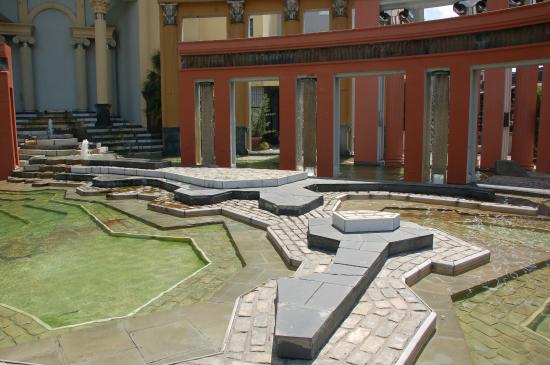
In the 41 years since it was built, it has been mocked as a gaudy mess fit for Disneyworld, a postmodern masterpiece, and a vibrant creation that brings joy to downtown NOLA. But, with water shooting out of the expressive faces of clay-colored masks, there’s no doubt it makes for an excellent addition to one’s New Orleans photo album. I snapped the picture, the couple thanked me, and then they walked on in the direction of the French Quarter.
When the Piazza d’Italia was originally designed, the connecting parking lot was actually meant to be more … charming. And the piazza wasn’t meant to be a photo op one merely passed through. It was meant to be a space where people gathered, conversed, ate and laughed.
That goal hasn’t yet been achieved. But to understand why it was created in the first place, we have to understand the time in which it was conceived.
Part of a downtown renaissance
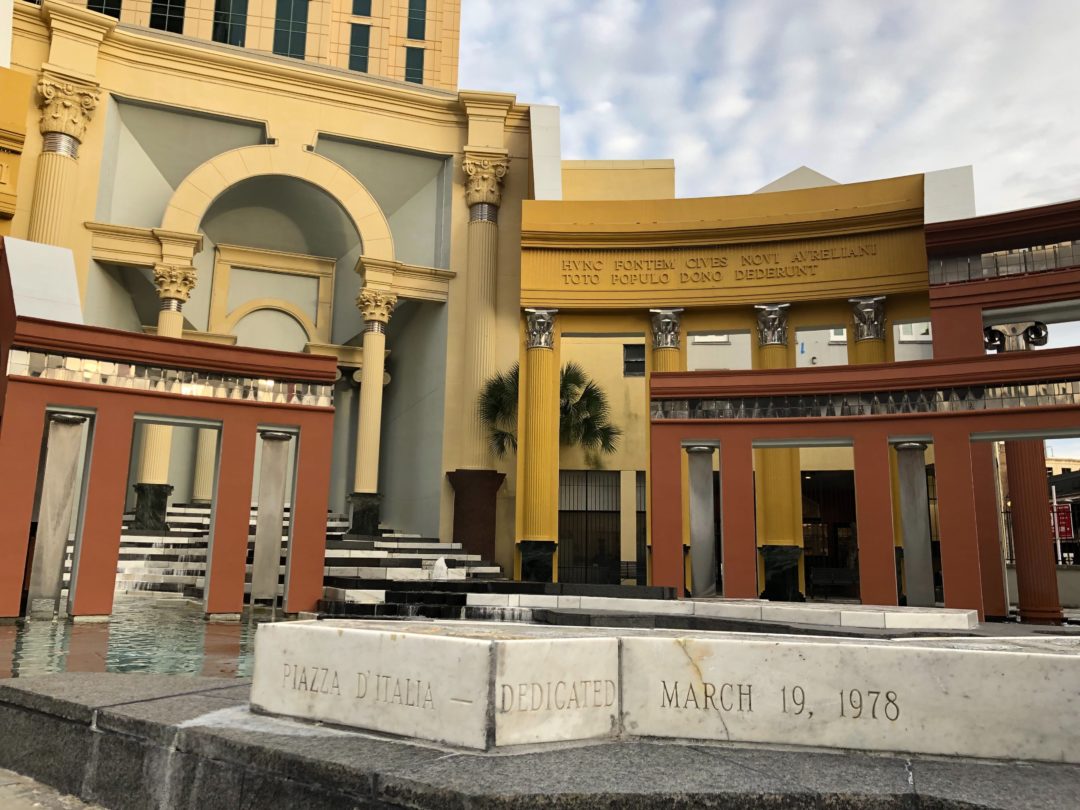
But it was believed New Orleans — anchored by tourism and the French Quarter — had avoided that fate. And after reading the article, it was easy to believe a downtown renaissance was afoot. The author talked optimistically about current staples of downtown New Orleans that — at the time of his writing — were being imagined, designed, or built. They included the Superdome, the Riverwalk Mall, Spanish Plaza, One Shell Square, the Mahalia Jackson Theater, Louis Armstrong Park and so many others, including the subject of this article — a monument to the important contributions of New Orleans’ Italian-American community.
At the turn of the 20th century, between 1884 and 1924, an estimated 290,000 Italian immigrants, who were mostly from Sicily and were fleeing economic and political turmoil — arrived in New Orleans and settled in the downriver section of the French Quarter, which became known as “Little Palermo” after Sicily’s capital. The ethnic group had a major influence on its new home’s culture in just about every facet, including, but certainly not limited to, food — see muffulettas at Central Grocery, gelato at Angelo Brocato, etc.– and jazz — see Louis Prima, the Dukes of Dixieland, etc.
By the time the 1970s rolled around, the Italian-American leaders who commissioned the Piazza felt that, while the city’s French, Spanish, African and American Indian influences were being properly celebrated, New Orleans’ Italian elements were not being given appropriate attention.
So the city’s progressive mayor, Moon Landrieu — who was on board for just about any development that might help revitalize downtown — agreed the time was right for a monument to our Italian-American heritage.
Outgoing, absorptive and engaging
In the competition to determine who would design this monument, the local firm — August Perez and Associates — won with a design that focused primarily on redeveloping the warehouses around the square. The second-place design was by the nationally renowned architect, Charles Moore, whose design focused on the interior of the space. Because the designs were, in large part, complimentary, it was decided they would work together on the project.
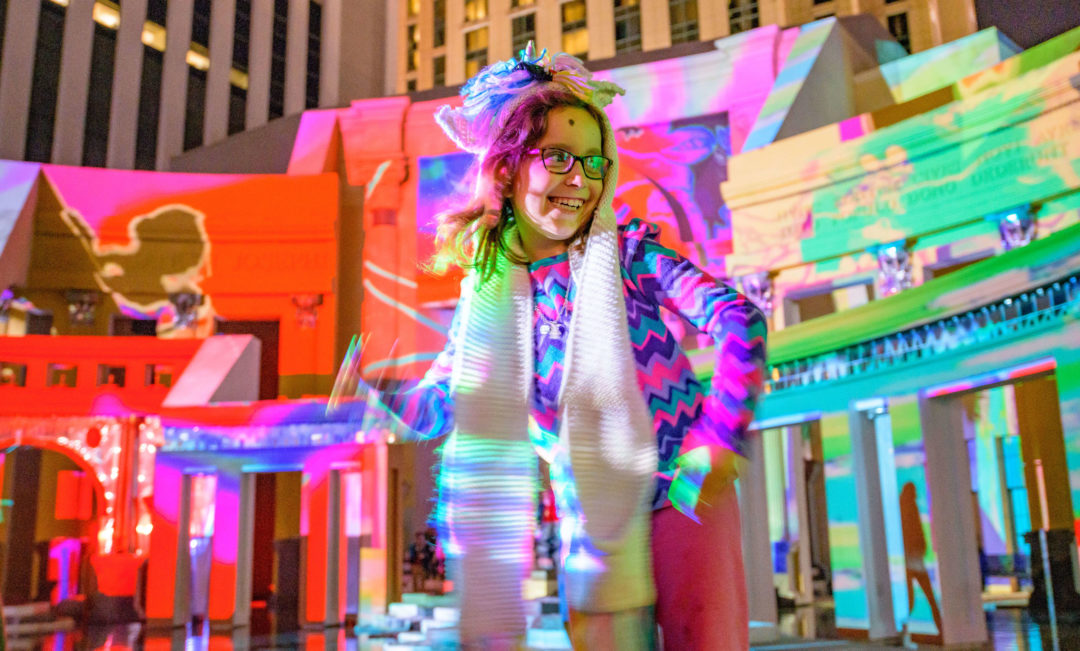
Moore’s personality was described as “outgoing, absorptive and engaging.” Born in 1925, he earned his master’s and doctoral degree at Princeton University and then traveled around the country — teaching at a university’s architecture school and setting up a firm in that city — before moving on to his next university and teaching gig. By the time he submitted his design for the Piazza d’Italia, he was the dean of the esteemed Yale School of Architecture.
His designs could probably also be described as outgoing, absorptive and engaging. He preferred — picture the Piazza d’Italia while you read this — conspicuous design features, loud color combinations, stylistic collisions, esoteric historical designs, and non-traditional materials. His most famous piece is the Sea Ranch vacation community, along a stretch of rocky California coast — a village of redwood-clad buildings sitting atop a dramatic seaside landscape.
https://www.instagram.com/p/Bk5rlrllJgh/?utm_source=ig_share_sheet&igshid=a8ntaehjt9s7
Sea Ranch was spartan on the outside, but bold on the inside: many of the condominiums were decorated with bright, conspicuous supergraphics. And wild interiors were common in Moore’s work. His own mid-1960s New Haven residence, for example, was featured in Playboy and boasted an open, freestanding shower in the middle of the room, with water flowing through a giant sunflower!
A polarizing work of art
When designing Piazza d’Italia, Moore turned his penchant for animated interiors inside out, with the exterior turning heads. Here is how Paul Goldberger, architecture critic for The New York Times, described the piazza in March 1979:
“For, while downtown plazas in most cities are mere expanses of empty concrete, this new one has as its centerpiece a set of curving walls containing an array of classical columns and arches and entablatures and friezes, all painted brilliant rust and yellow and orange and awash with water spouting, flowing, rushing and gurgling around and about and above and below every part of it.
“As if that were not enough, the structure is lit up with blue and orange neon ornamentation at night. And the fountains all empty into the central pool with an island of cobblestone and slate and marble that clearly and unquestionably turns out to be the shape of a map of Italy.
“The whole thing is a wild, mad vision as if the Roman Forum were re-erected in Las Vegas. One’s first instinct is to say it is all rather a vulgar slap in the face of classicism — how could Corinthian columns be painted yellow and lit up at night with neon be anything but vulgar?”
“Vulgar” was a common description for the space. Others called it “ugly” and “inane.”
But it was all intentional.
Moore wanted his buildings to connect with everyday people. He admired the way Italians interacted with their piazzas, and he wanted a space that would be similarly fun, colorful, vibrant and welcoming for New Orleanians. He admired Italian history, which is why the Piazza d’Italia is a mashup of styles, borrowing elements from classical times to the baroque period.
Other postmodernists used classical elements to poke fun at modernist orthodoxy, but Moore insisted his was a joyful tribute.
While many critics maintained their disappointment with Moore’s work, likening it to Disneyworld and Las Vegas, Goldberger went on to clarify his commentary:
“But this place, which may be the most significant new urban plaza any American city has erected in years, is in fact so boundlessly good-natured, so utterly full of good will and eagerness to please, that you soon realize that it is not a mockery of classicism at all. It is a laughing, almost hysterically joyous embrace of the classical tradition.”
“Great Architecture tends to inspire admiration, reverence, humility, awe, and other such solemn emotions,” reads a segment on the American Italian Cultural Center’s website. “But rarely does it fill its beholder with feelings of happiness, joy, warmth, and love. The Piazza d’Italia is one of those exceptions.”
That was its intent.
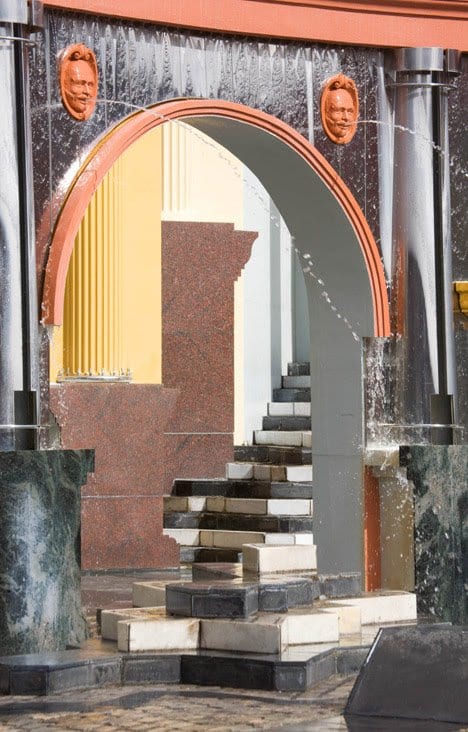
A bust, A revival, and hope
In 1973, those who thought New Orleans’ downtown had turned the corner and was on its way to a renaissance, didn’t envision the oil bust of the late 1970s. As investment flowed out of New Orleans, the vision for redeveloped warehouses surrounding the piazza and creating a “surprise plaza” never manifested.
Instead, a surface-level parking lot borders much of the space. And, in the following decades, the piazza, itself, fell into disrepair. By 2000, it was frequently mocked as the world’s first “postmodern ruin.”
https://www.instagram.com/p/BY3XLmhnKbS/?utm_source=ig_share_sheet&igshid=19zp130wxlf3a
But that’s not where this plaza’s story ends.
In 2004, the first renovation of the space was completed. The fountain was rehabilitated and, unfortunately, the badly deteriorated campanile, or bell tower, on the site’s periphery was removed. Between 2013 and 2018, a second renovation was completed, led by Moon Landrieu’s son, then-Mayor Mitch Landrieu.
Today, the space is operated by Loew’s Hotel. It was reopened to the public in November and is already gaining popularity as an event space. “Our hope,” explained Loew’s Hotel director of sales and marketing, Barry Rodriguez, “is that Piazza d’Italia will become the urban park that has been envisioned for years.”
https://www.instagram.com/p/BrDXYoplsV8/?utm_source=ig_share_sheet&igshid=15xdq01f1chx7
In its first months back, it has been used as a wedding space, as well as for social and corporate events. It was an addition to Luna Fete, Arts Council New Orleans’ massive winter lights event that attracts 50,000 visitors each year, and — this Carnival, on Feb. 22, from 6 p.m. until 10 p.m. — it will be the site of the Virtual Krewe of Vaporwave’s three-movement rock opera, Oedipus Max.
[embedyt] https://www.youtube.com/watch?v=yp1WyUkSpvk[/embedyt]
For residents who have stumbled upon Piazza d’Italia, it’s common to hear them describe it as a surprise. And, even though I knew it was there when I walked from Poydras Street, under the sign that bears its name, it still felt like I was walking into a different time. Or maybe as if I was caught between two times, or a lot of different times.
It’s kind of confusing. It’s kind of gaudy. Don’t say it too loud, but it’s kind of beautiful.
It’s undoubtedly unique.
And it’s ours.
The inscription on the temple reads, “FONS SANCTI JOSEPHI. HVNC FONTEM CIVES NOVI AVRELIANI TOTO POPULO DONO DEDERUNT.” That translates to “The Fountain of St. Joseph: The citizens of New Orleans have given this to all the people as a gift.”
So enjoy it. Take time to walk along its curves, between its fountains, and through its colonnades. Maybe even consider purchasing the very reasonably priced tickets to the Virtual Krewe of Vaporwave’s spectacular event, which looks like it’s going to be as wild as the space itself.
https://www.instagram.com/p/BrGV7-oF4y9/?utm_source=ig_share_sheet&igshid=xs7pjqplti21
And, maybe one day, that vision from more than 40 years ago will be realized. People won’t just walk through Piazza d’Italia for a photo. We’ll stay for a glass of wine and listen to live music on the steps. We won’t see a parking lot. We’ll be surrounded by colorful New Orleans’ buildings.
And we’ll learn to appreciate one of our truly hidden gems.

